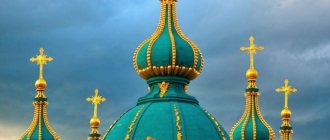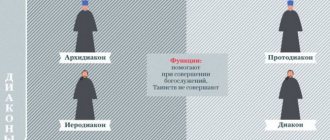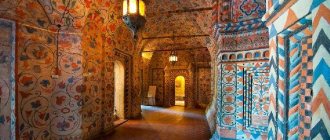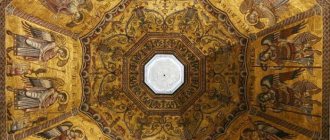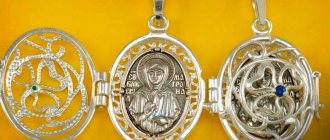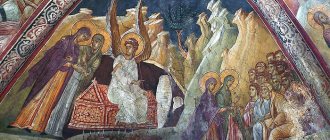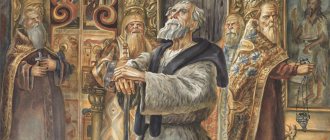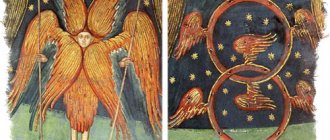Church hierarchy that came from Old Testament times
The order in which ecclesiastical titles among Orthodox Christians are divided into three different degrees dates back to Old Testament times. This happens due to religious continuity. It is known from the Holy Scriptures that approximately one and a half thousand years before the birth of Christ, the founder of Judaism, the prophet Moses, selected special people for worship - high priests, priests and Levites. It is with them that our modern church titles and positions are associated.
The first of the high priests was Moses' brother Aaron, and his sons became priests, leading all the services. But in order to perform numerous sacrifices, which were an integral part of religious rituals, assistants were needed. They became the Levites - the descendants of Levi, the son of the forefather Jacob. These three categories of clergy of the Old Testament era became the basis on which all ecclesiastical ranks of the Orthodox Church are built today.
Lowest level of priesthood
When considering church ranks in ascending order, one should start with deacons. This is the lowest priestly rank, upon ordination to which God’s Grace is acquired, necessary to fulfill the role assigned to them during the divine service. The deacon does not have the right to independently conduct church services and perform the sacraments, but is only obliged to help the priest. A monk ordained a deacon is called a hierodeacon.
Deacons who have served for a sufficiently long period of time and have proven themselves well receive the title of protodeacons (senior deacons) in the white clergy, and archdeacons in the black clergy. The privilege of the latter is the right to serve under the bishop.
It should be noted that all church services these days are structured in such a way that, in the absence of deacons, they can be performed by priests or bishops without much difficulty. Therefore, the participation of the deacon in the divine service, while not being obligatory, is rather its decoration than an integral part. As a result, in some parishes where serious financial difficulties are felt, this staffing unit is being reduced.
Black clergy
Represented by people who have taken monastic vows. Let's consider who belongs to the black clergy.
Hierodeacons and archdeacons
Monks performing the duties of a deacon: help priests during divine services and church sacraments (bringing the necessary attributes, reading prayers).
Archdeacon - occupies the rank of the most senior among the hierodeacons.
Hieromonks
Hieromonk = priest, he conducts various sacred sacraments. This rank can be achieved by representatives of the white clergy who decide to become monks or by people who have been ordained (they receive the right to conduct the sacraments).
Abbots (abbesses)
They act as abbots or abbess of a church or monastery. Previously, this rank was given as a reward for showing merit to the church. And since 2011, the patriarch decided that any abbot of the monastery can become hegumen (abbess).
A characteristic attribute of the abbot is the staff, which he uses when walking around his territory.
Archimandrites
One of the highest Orthodox ranks. The priest who receives it receives a miter. Archimandrites wear black monastic clothing, which distinguishes them from other monks due to the presence of red tablets on it.
And if he also holds the rank of rector of a temple or monastery and has the right to carry a special staff, then he is addressed with the words “Your Reverence.”
Bishops (or overseers)
This rank applies to bishops. Bishops have the greatest grace of God; they are allowed to conduct any sacred rites, even the ordination of deacons. They wear a red robe. The archbishop is the most important of the bishops.
An ancient Christian tradition says that only a bishop is allowed to bless the service in the temple, using an antimis (a scarf with sewn-in pieces of the relics of a holy person).
In addition, the responsibilities of the bishop include control and guardianship of all churches and monasteries located on the territory of his diocese. Bishops are addressed with the words “Your Eminence” or simply “Vladyka.”
Metropolitans
The high ecclesiastical rank, the highest of the titles of a bishop, is the oldest on earth. The Metropolitan is subordinate only to the Patriarch. You can understand that this is a metropolitan if you look closely at his attire:
- wear a blue robe;
- have a white hood with a cross, inlaid with precious minerals (and all representatives of lower ranks wear black hoods).
You can become a metropolitan only by showing great merit to the church.
Second level of the priestly hierarchy
Looking further at church ranks in ascending order, we should focus on priests. Holders of this rank are also called presbyters (in Greek, “elder”), or priests, and in monasticism, hieromonks. Compared to deacons, this is a higher level of priesthood. Accordingly, upon ordination a greater degree of the Grace of the Holy Spirit is acquired.
Since evangelical times, priests have been leading divine services and have the right to perform most of the holy sacraments, including everything except ordination, that is, ordination, as well as the consecration of antimensions and the world. In accordance with the official responsibilities assigned to them, priests lead the religious life of urban and rural parishes, in which they can hold the post of rector. The priest is directly subordinate to the bishop.
For long and impeccable service, a priest of the white clergy is rewarded with the title of archpriest (chief priest) or protopresbyter, and a black priest is rewarded with the rank of abbot. Among the monastic clergy, the abbot, as a rule, is appointed to the position of rector of an ordinary monastery or parish. If he is entrusted with leading a large monastery or monastery, he is called an archimandrite, which is an even higher and more honorable title. It is from the archimandrites that the episcopate is formed.
Beginning of the hierarchy
The term “church account” is used both in a narrow and broad sense. In the first case, this phrase means a collection of clergy of the lowest rank, who do not fit into the three-degree system. When they speak in a broad sense, they mean clergy (clergy), whose association constitutes the staff of any church complex (temple, monastery).
Parish of the Orthodox Church
In pre-revolutionary Russia, they were approved by the consistory (an institution under the episcopate) and personally by the bishop. The number of lower-ranking clergy depended on the number of parishioners seeking communication with the Lord. The congregation of the large church consisted of a dozen deacons and clergy. To make changes in the composition of this state, the bishop was required to obtain permission from the Synod.
In past centuries, the income of the account consisted of payments for church services (clergy and prayers for the needs of the laity). Rural parishes, served by lower ranks, were provided with plots of land. Some readers, sextons and singers lived in special church houses, and in the 19th century they began to receive salaries.
For information! The history of the development of the church hierarchy has not been fully disclosed. Today they speak with confidence about three degrees of priesthood, while the early Christian titles (prophet, didaskal) have practically been forgotten.
The meaning and significance of the ranks reflected the activities that were authoritatively announced by the Church. Previously, the brethren and the affairs of the monastery were managed by the abbot (leader), who was distinguished only by his experience. Today, attainment of ecclesiastical rank is similar to an official reward received for a certain period of service.
About the life of the Church:
- Is it possible to be late for church services?
- Learning to sing in a church choir
- Is it possible for Orthodox Christians to attend churches of other religions?
Bishops of the Orthodox Church
Further, when listing church titles in ascending order, it is necessary to pay special attention to the highest group of hierarchs - bishops. They belong to the category of clergy called bishops, that is, heads of priests. Having received the greatest degree of Grace of the Holy Spirit at ordination, they have the right to perform all church sacraments without exception. They are given the right not only to conduct any church services themselves, but also to ordain deacons to the priesthood.
According to the Church Charter, all bishops have an equal degree of priesthood, with the most honored of them being called archbishops. A special group consists of the capital's bishops, called metropolitans. This name comes from the Greek word "metropolis", which means "capital". In cases where another is appointed to assist one bishop holding a high position, he bears the title of vicar, that is, deputy. The bishop is placed at the head of the parishes of an entire region, called in this case a diocese.
Sextons (sacristans) and clergy
When Christianity arose, they played the role of guardians of temples and sacred places. The duties of the gatekeepers included lighting the lamp during divine services. Gregory the Great called them “guardians of the church.” The sextons were in charge of the selection of utensils for the rituals; they brought in prosphora, blessed water, fire, wine, lit candles, cleaned the altars, and reverently washed the floors and walls.
Today, the position of sexton has been practically reduced to zero; the ancient duties are now assigned to the shoulders of cleaners, watchmen, novices and ordinary monks.
- In the Old Testament the term "clergy" refers to the lower ranks and the common people. In ancient times, representatives of the tribe (tribe) of Levi became clerics. The people were called all those who were not distinguished by “true” birth.
- In the book of the New Testament, the criterion of nation is omitted: now the lowest and highest rank can be received by any Christian who has confirmed compliance with certain canons of religion. Here the status of a woman who is allowed to obtain an auxiliary position is raised.
- In ancient times, the people were divided into laymen and monks, who were distinguished by great asceticism in life.
- In a narrow sense, clergy are clergymen standing on the same level as clerics. In the modern Orthodox world, this designation has extended to priests of the highest rank.
The first level of the hierarchy of clergy
In the first Christian communities, deacons were the bishop's assistants. Today they minister the word of God by reading scriptures and offering pleas on behalf of the congregation. Deacons, who always ask for a blessing for work, burn incense in the church building, and help perform the proskomedia (liturgy).
The deacon assists the bishop or priest in performing divine services and sacraments
- Naming without specification indicates that the minister belongs to the white clergy. The monastic order is called hierodeacons: their clothes do not differ, but outside of liturgies they wear a black cassock.
- The eldest in the rank of diaconate is the protodeacon, who is distinguished by a double orarion (long narrow ribbon) and a purple kamilavka (headdress).
- In ancient times, it was common to give the rank of deaconesses, whose task was to care for sick women, prepare for baptism and assist priests. The question of reviving such a tradition was considered in 1917, but there was no answer.
The subdeacon is the deacon's assistant. In ancient times they were not allowed to take wives. Among the duties was the care of church vessels, the covers of the altar, which they also guarded.
For information! In the present, this rite is observed only in the services of the bishop, whom the subdeacons serve with all diligence. Students of theological academies often become candidates for rank.
Second level of the hierarchy of clergy
Presbyter (head, elder) is a general canonical term that unites the ranks of the middle order. He has the right to administer the sacraments of communion and baptism, but does not have the authority to place other priests in any place in the hierarchy or to bestow grace on those around him.
The priest at the head of the parish community is called the rector
Under the apostles, elders were often called bishops, a term meaning “overseer,” “overseer.” If such a priest had wisdom and honorable age, he was called an elder. The book of Acts and Epistles says that the elders blessed the faithful and presided in the absence of the bishop, they taught, performed many sacraments and received confessions.
Important! The Russian Orthodox Church puts forward rules that say that today this church level is available only to monks with a theological education. Elders are required to have ideal morality and an age above 30 years.
This group includes archimandrites, hieromonks, abbots and archpriests.
Primate of the Orthodox Church
And finally, the highest rank of the church hierarchy is the patriarch. He is elected by the Council of Bishops and, together with the Holy Synod, exercises leadership over the entire local church. According to the Charter adopted in 2000, the rank of patriarch is for life, but in some cases the bishop's court is given the right to try him, depose him and decide on his retirement.
In cases where the patriarchal see is vacant, the Holy Synod elects a locum tenens from among its permanent members to perform the functions of the patriarch until his legal election.
Church workers who do not have the Grace of God
Having mentioned all the church titles in ascending order and returning to the very base of the hierarchical ladder, it should be noted that in the church, in addition to the clergy, that is, clergy who have passed the sacrament of ordination and have been honored to receive the Grace of the Holy Spirit, there is also a lower category - clergy. These include subdeacons, psalm-readers and sextons. Despite their church service, they are not priests and are accepted into vacant positions without ordination, but only with the blessing of the bishop or archpriest - the rector of the parish.
The duties of the psalmist include reading and singing during church services and when the priest performs the requirement. The sexton is entrusted with calling parishioners to the church by ringing bells for the beginning of services, ensuring that the candles in the church are lit, if necessary, helping the psalm-reader and handing the censer to the priest or deacon.
Subdeacons also take part in divine services, but only together with bishops. Their duties are to help the bishop put on his vestments before the start of the service and, if necessary, change his vestments during the service. In addition, the subdeacon gives the bishop lamps - dikiri and trikiri - for blessing those praying in the temple.

